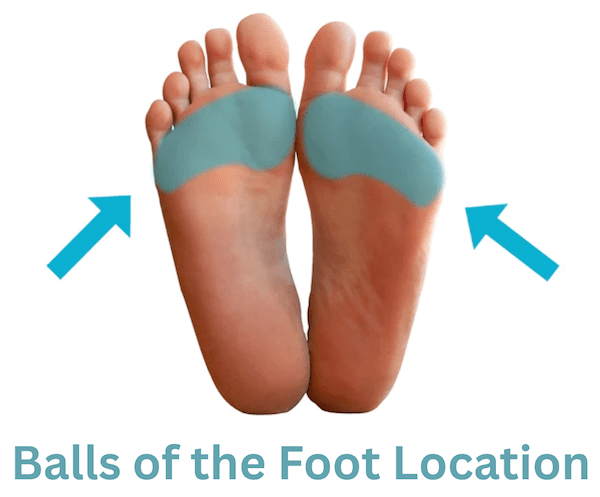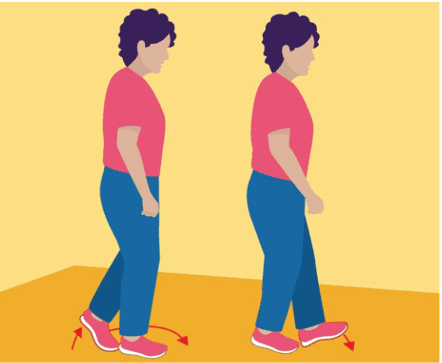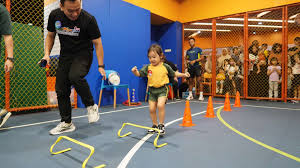How to Stop Toe Walking: What Worked for My 6 Little Ones
Seeing your child take their very first steps is pure magic: it’s a moment that every parent treasures.
Children walk on their toes until the age of 3 years. Some children naturally walk on their toes to balance their body weight. But what if a child is always up on their toes? This might sometimes signal something more serious.
My daughter Fiona was diagnosed with toe walking when she was three. Our hearts pounded to see our dear daughter unable to walk properly. Fortunately, with proper treatment, her toe walking stopped, and she started walking normally at the age of 5.
After that, I met many parents facing the same challenge. I’ve noticed that some parents may not be aware of this issue. And those who are aware get overwhelmed at first. That is why I have written this article to raise awareness in parents whose children are tiptoeing while walking. In this article, we will understand the meaning of toe walking, its symptoms, reasons, and useful ways to treat it.
So, let’s dive right into it.
Table of Contents

What Is Toe Walking In Children?
Toe walking is a physical condition in which children continuously walk on their toes. They use the balls of their feet to walk, and their heels never touching the ground.

Ideally, a child starts to walk between 12 and 15 months of age. They start walking with a heel-to-toe pattern. Many children toe-walk slightly to balance their body weight when they slow down after running or want to start running.
After 2 or 2.5 years, they learn to keep the heels and balls of their feet on the ground to walk like a normal child.
But if a child continues to walk on toes even after 3 years of age, it may be a BIG RED FLAG indicating idiopathic toe walking.
Common Symptoms of Toe Walking:
If you ask your child to walk flat-footed, but they still choose to stay up on their toes, watch for these signs:
- Pain or discomfort in the feet
- Poor balance and coordination while walking
- Facing issues with playing recreational activities or games that require walking
- Frequent falls while walking due to an imbalance
- Heels that never touch the ground while walking
- Tightness in the heel cords (Achilles tendons)
Also Read: How to Increase Strength in Baby’s Legs for Walking?
Why Does Toe-Walking Happen in Children?
Here are the main reasons for having a toe-walking disorder:
1. Some children have a shortened Achilles tendon (calcaneal tendon).
This tendon is a tissue band that joins the calf muscles to the heel bone in the back of the leg. It is the strongest and thickest one among all tendons in our body.
There are two types of calf muscles in the back of the leg: gastrocnemius and soleus.
When we use these calf muscles for activities like walking, running, etc., the Achilles tendon pulls up the heel bone.
But if the tendon is shorter than the normal length, the kid toe walks instead of using the heel. This condition may occur congenitally in children.
2. Some children have tight muscles and tendons in their calves.

It causes excess strain in the calves and the heel while moving the foot. Due to this, children feel pain while walking or running if they try to put their heel on the ground.
3. For some children, toe walking becomes a habit even if they have normal Achilles tendons and relaxed calf muscles. It may be due to their sensory reflexes.
4. The toe-walker child may have a severe medical condition like:.
- Muscular dystrophy
- Abnormality in the spinal cord
- Cerebral palsy
- GLUT1 Deficiency Syndrome (lowered CSF glucose levels)
- Autism spectrum disorder (ASD)
Recommended Reading: How to Measure Baby’s Shoe Size at Home?
How to Stop Toe Walking in Children?
The severity of toe walking differs from child to child, depending on age and the underlying cause of the condition.
Here are the common approaches taken to stop toe walking in children:
1. Observation:
The early intervention for this situation is to wait and watch the movements of a tiptoeing child. Pediatricians often keep a period of 4-5 weeks to see how the child walks without treatment. If it is a temporary habit, it will go away with some exercises.
1.1. Sensory Approach:
Doctors suggest including sensory activities in your child’s daily playtime, such as:
- Tell them to walk backwards for a few steps. Make sure they lay their feet flat on the ground. This enhances their body coordination and balance.
- Ask them to walk on balance beams or with weighted vests. It makes them aware of their body movements.
- Take them barefoot in an open garden. Let them walk on fallen wood logs, trails, hilly areas, etc. (also check my detailed guide on when babies should wear shoes).
- Go slow. Let them do these activities at their own pace!
2. Physical Therapy:
2.1. Stretching:
I would suggest going with BASICS first!
Children are so active, and they learn fast. Adding physical exercises to their routine can help to lessen the toe-walking pattern. Some children often show signs of increased foot movements after stretching.
Physical therapists teach such children how to stretch the calf and foot muscles. This releases the tension in tight muscles, lessens ankle strain, and adds strength in the weak muscles.
2.1.1 Heel Cord Stretch:
This pose stretches the calf muscles and the Achilles tendon.
- Let your child lie down on the flat surface.
- Extend their one leg and hold it in your hand.
- Gently pull their toe towards their shin in an upward direction.
- Repeat the same for the other leg.
2.2. Yoga:
It is the MOST EFFECTIVE WAY to treat this condition naturally!
I suggest you do these poses with your little one to encourage them. Ensure you keep these activities fun so the child can perform them willingly!
You take the help of a yoga teacher to learn the stretching and strengthening poses for your kid. Here are some of my favorite yoga poses that we tried with Fiona when she was toe walking:
2.2.1 Child’s Pose / Downward-Facing Dog:
It is called ‘Adho Mukha Svanasana’.
This yoga pose stretches the hamstring and calf muscles in the backs of the legs. Here is how to do it:
- Tell the child to stretch the arms straight forward and the legs straight.
- The distance between their legs should be a foot apart, and their shoulders should be a width apart.
- Tell them to bend their head to touch the floor and raise their hip as high as possible.
- The weight of their body should come on the palms and feet.
2.2.2 Frog’s Pose/ Mandukasana:

- Let your child sit on the floor with their knees as far apart as possible. Their feet should touch their buttocks
- They can keep their hands on their knees or the floor. Let their body feel that natural stretch with the frog’s pose.
- Tell them to walk or hop like a frog in that position. This strengthens the calf muscles and tendons in the feet.
2.3. Heel-Toe Walks/Tandem Walk:

- Tell your child to open their arms in an upward direction to balance the body.
- Ask them to take one step where their heel touches the ground.
- In the same line, tell them to take the next step using the other leg.
- Continue walking in this way for a few minutes.
- Stand your child near a wall so they can support themselves while walking if needed.
3. Professional Medical Help:
3.1. Casting:
For some severe cases, doctors add serial casts on the child’s leg. It is changed every 2-3 weeks with increased stretch. It stretches the child’s calf muscles and Achilles tendons. As the body naturally adapts to this change, the child becomes able to walk normally without a cast.
3.2. Bracing:
Doctors suggest wearing braces on the child’s foot during the day, night, or both as needed. These braces reduce pain and improve gait.
3.2.1. Ankle-Foot Orthoses (AFOs):
These braces cover the leg from the calf muscle area to the toes. They keep the foot at a 90-degree angle. It stretches and lengthens the calf muscles and the Achilles tendon. These braces help the child to walk on their heel instead of their toes throughout the day.
3.2.2 Supramalleolar Orthoses (SMOs):
These braces are shorter and more flexible than AFOs. They only support the ankle and balance the foot. They are lighter and provide more mobility than AFOs. They are suggested for children who have strong calf muscles but a weak Achilles tendon. Also, doctors change the treatment from AFOs to SMOs when there is a significant improvement in the child’s walking.
3.3 Botulinum A Toxin (Botox) Injection:
Doctors inject Botox A toxin into the child’s gastrocnemius and soleus muscles (two calf muscles). This medicine reduces the existing tension in those muscles and weakens them. It reduces the muscle contraction of the calf muscles. This enables calf muscles to stretch without much pain.
Doctors combine these medications with serial casting or splinting to maximize the chances of normal walking. This is not a permanent solution. It is all about TRIAL AND TEST. You must consult a good doctor before finalizing this approach.
3.4. Surgery:
Surgery is useful for children who do not respond to physical therapy, yoga, Botox injections, or bracing for treating toe walking. Achilles tendon lengthening surgery is done to loosen and lengthen the calf muscles and Achilles tendons. But it is advisable for children above 5 years as it involves full anesthesia.
After surgery, doctors prescribe a suitable below-the-knee walking cast to the child for the next 6 weeks. Later, the child is shifted to AFOs.
For children below 5 years of age, toe walking is treated using approaches other than surgery.
Personal Tips to Reduce Toe Walking:
I have tried these approaches for Fiona when she was toe walking:

1. Sitting on a Peanut Ball:
Make the child sit on a therapy ball.
Tell them to move the bodyweight front and back using their ankles.
It strengthens the calf muscles and ankles.

2. Walking Over Cone Hurdles
Keep playing cones and hurdles in the child’s path. Tell them to walk over these hurdles while maintaining their balance. This improves their foot coordination. The child can jump, too, if possible.

3. Pick and Lift Using Toes:
Tell the child to pick up the small balls with their toes and put them in a bowl.
It adds strength to calf muscles.
How Do Doctors Diagnose Toe Walking?
- Gait analysis: to examine a child’s foot movements during walking.
- EMG: To check how the calf muscles and nerves are working in the leg.
- Neurological testing: to check whether there are any developmental delays or issues in the child’s brain and spinal cord.
Frequently Asked Questions:
Do adults get the toe-walking condition?
Yes. Some adults with issues in the heel and calf muscles may toe walk. It includes possibilities such as a weak Achilles tendon, low muscle power, corns, calluses, and peripheral neuropathy. In some cases, it may return in adulthood if the person received incomplete treatment in childhood.
Is Toe Walking Common In Children?
Yes. Most children under the age of 5 walk on their toes when they learn to walk. For normal children, it is just a phase. If there are developmental delays, children tend to toe walk for longer.
Conclusion:
Toe walking is manageable if we take guided actions with the help of doctors. Early diagnosis and proper treatment prevent this condition. I hope this guide has given you valuable insights.
I can understand that your child is the apple of your eye! You can save your child’s future if you take the right actions today! Regular exercise and guided sensory activities also help to reduce the chances of this condition in children.
Don’t worry if your little one is showing signs of this condition. Be calm and follow the correct medical help for faster recovery!






![When to Flip a Baby Mattress? [A Complete Guide]](https://www.imperfecthomemaking.com/wp-content/uploads/2024/02/when-to-flip-a-baby-mattress-768x432.png)